Harry Armstrong and Don Armstrong, Father and Son
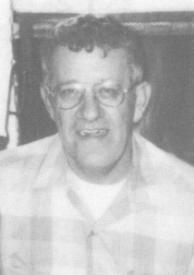 |
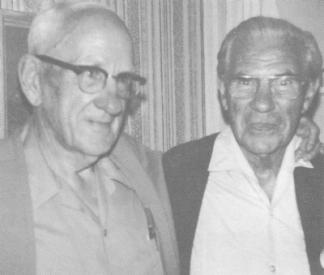 |
| Don Armstrong | Harry Armstrong (left) with his brother Lloyd Armstrong (right) |
Being the son or grandson of E.P. Armstrong is something to live up to when it comes to filing saws, and Don is proud of his father’s record as one of the leading filers in the Northwestern part of the United States for more than fifty years. When Don was only a year old, Harry Armstrong moved his family from Portland, Oregon to Longview, Washington to take the job of head filer at Mill 3 when it opened in 1928. This was one of three major mills in the huge complex which Weyerhaeuser built on the banks of the Columbia River in Longview. Archie Peru and Bill Murphy were the other two filers. Each mill was an example of all that was new in sawmilling, and the filing rooms were among the first to be all Armstrong-equipped. Some of the larger machines were new designs, fresh from E.P. Armstrong’s drawing board. In 1942 Hany was transferred to Mill No. 2 as head filer. In 1960, thirty-two years after he began with Weyerhaeuser, Harry retired.
Harry had started filing when he was 14 years old in 1908 at Standard
Lumber and Box Company in Portland, Oregon. His dad, E.P. Armstrong, had
for some time been both filing the mill and operating his shop, turning
out Armstrong swages and shapers. The mill was at the east end of the
Burnside bridge across the Willamette River in downtown Portland, Oregon,
and his shop was at the west end. It took several quick ten-minute hikes
across the bridge each day to keep both jobs going. With an inserted tooth
circular head rig, a pony band saw, and a rip saw, Standard Lumber and
Box
was a one-man filing job, just the right size for E.P ‘s purposes.
By 1908 his manufacturing operation had grown enough to demand full time attention. He decided to give up filing, but keep the job in the family. With E.P. Armstrong’s assurance that he would see that the filing job would be done right, Standard Lumber and Box installed young Harry Armstrong age 14, as head filer. E.P. installed a drawing board in one corner of the filing room where he spent a good share of his time in the beginning, working on his swage and shaper designs and keeping an eye on his son at the same time. It worked, and Harry filed the mill until it burned in 1914.
Then Harry moved across the Willamette River, too, and joined his dad in the manufacture of swages and shapers. Harry was in charge of the production shop for a time, but as so often happens with fathers and sons, Harry and his dad did not always agree. It was not too long before Harry returned to filing, and he worked many of the big mills which were so plentiful in the Northwest in the early part of the century.
Lloyd Armstrong, Harry’s younger brother, also went to work in his father‘s shop at the same time. Before long E.P. saw to it that Lloyd got some sawmill filing experience, and he was a head filer before he returned to the shop to work with his father. Lloyd remembers his filing background proved invaluable in his work at the factory, and he eventually became President of Armstrong Manufacturing Company when E.P. Armstrong died in 1942.
Don Armstrong was born in l927, just before Harry took the Weyerhaeuser job in Longview. Although he remembers saws and saw filing as an every day part of his life all during the years he was growing up, Don never worked in the filing room with his father. “Dad had the feeling that saw filing as a profession had peaked, and didn’t hold much promise for a young fellow,” Don recalls.
With this advice, Don turned to other things after high school. He drove
truck, spent two hitches in the U.S. Marine Corps, one in 1945 in World
War II and again in 1950-51 during the Korean conflict, and tried numerous
jobs without finding something he wanted as a career. He says he finally
told his dad, “I want to file saws”.
It was the right moment to come to that decision. Aborigine Lumber Company
in Longview needed a head saw filer. Just as EP. Armstrong had done with
him, Harry recommended Don for the job, even though Don had had no actual
filing experience. With Harry’s guarantee that the work would be
done right, Don became head filer for Aborigine Lumber Company. This was
in 1956 when Don was 29, and Don recalls that it was not easy, but his
dad was there when he needed him. It worked out well, and Don was properly
launched on a filing career. In 1959 he took the head filing job at C&S
Lumber Company in Castle Rock, Washington, and a year later he was at
Blue Mfg. Company in Longview, Washington. In 1960 he took care of the
saws for both Johnston Lumber Company and Hutchins Lumber Company in Weippe,
Idaho at the same time. Other filing jobs followed around the Northwest,
and
then he decided to go into business for himself. For seven years he operated
a saw shop in Yakima, Washington. It was a busy shop, but he found he
really enjoyed saw filing more than managing all the details of running
a business, and he returned to the mills. 1978 found him filing for Homestake
Lumber Company in Spearfish, South Dakota. The mill burned in 1980, but
Don and his wife, Mary, liked the area and decided to stay. Together they
opened a saw shop, M-J Saws, which has grown rapidly, handling saws for
as many as 35 different mills.
Then the rumors that Pope and Talbot, Inc. would take over and re-build the Spearfish mill proved to be true, and Don left a good share of the operation of M-J Saws to Mary, to become Pope and Talbot ‘s head filer.
“It has been interesting,” Don comments. “Spearfish is not a lumber town, with a pool of experienced filing people. To build a filing crew, we set up a training filing room with new Armstrong equipment before the mill was built. In four months we trained six men as benchmen. Some had never seen a band saw. Now that the mill is cutting lumber, we have a crew of 16 men and a woman caring for the saws used in a two-shift operation. We average 1100 band saw changes each month.”
In thinking about his filing career so far, Don says he has put up saws for 73 different band mills. “In a couple of instances,” Don recalls, “Dad was able to spend some time with me on the job. It was great to work together and to get to know each other better. Either Dad or I had mellowed, probably both of us.” After retirement Harry Armstrong was in demand as a filing room trouble-shooter for a number of years. He died in 1982 at age 88.
Although he has worked with some good filers, Don says he learned most of his skills from his Dad and by trial and error on the job. In turn, Don has had his part in training others who have gone on to become head filers. These include Dave Halstead, now filing at Flodin Lumber Company, Thompson Falls, Montana, and Dick Von Borgan, filer at Wickes Forest Industries, Grangeville, Idaho. In his training programs Don looks for people who have an open mind, and are anxious to learn. “If you will be honest with yourself and analyze your problems, you can usually solve them,” he contends, and continues, “Don’t blame band mills or sawyers for problems with saws until you have looked at your own work. Always keep your mind open to new methods and ideas. Don’t get in a rut.”
In later years, Don is sure Harry had changed his ideas about the future
of saw filing, and was pleased his son had chosen filing as a career.
Don says he is proud to be a third generation Armstrong filer, and he
has never once regretted that day in 1956 when he told Harry, “I
want
to be a saw filer.”
Congratulations, Don. It is a pleasure to know that three generations and 101 years later, the name “Armstrong” is still right at the top of the list of good saw filers.
“I got into this profession by luck,” Tracy says. “I was hired off the street as a saw fitter, and had never been in a filing room or even a sawmill before. My first job was at W.K.O. in Carson, Washington, where Dennis Chisholm was the head filer. I learned to sharpen, swage and shape band saws on the day shift. This was in 1978, and there was no one to teach me. I learned to weld saws by myself by trial and error, using the Armstrong Saw Filer’s Handbook as a guide.
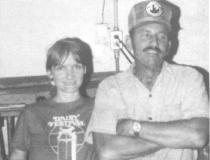 |
Tracy Garner, night filer, with head filer Frank Weaver, in the filing room at Crown Zellerbach’s quad mill in Holden, Louisiana. |
Tracy says the goal of the night shift is, “we can do it if you can.” We are sure that Frank Weaver and the day shift crew have no argument with that. It is a pleasure to salute the entire filing crew on a job well done.
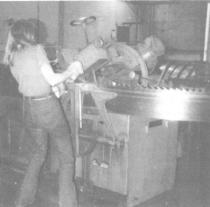 |
Tracy Garner dresses the grinding wheel on a No. 4 Armstrong band saw sharpener. The filing room at Crown Zellerbach’s mill in Holden is fully Armstrong-equipped. |
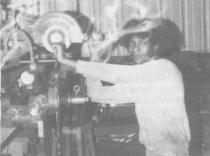 |
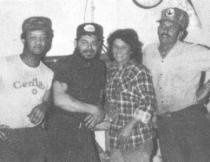 |
| Sandra Lynch, night fitter, face grinds a carbide tipped saw with a No. 54-C Armstrong sharpener. | From left to right: Ronald Jackson, carbide filer, Butch Fabre, day fitter, Johnnie Gautier, former night fitter, and Frank Weaver, head filer. Since this photo was taken, it was necessary for Johnnie to leave, and Sandra Lynch is presently the night fitter. |
| IN MEMORIAM
Ted Andrianoff When Ted Andrianoff came to work at Armstrong on February 6,1936, he was 22. He had experience as a machinist but it was his knowledge about hardening steel parts such as eccentric dies and anvils for swages that got him the job on strictly a trial basis. He always said his trial period was never officially over, but he soon became a leadman, then superintendent of production, Vice President of the corporation, President, and finally President and Chairman of the Board of Directors. A serious stroke made him inactive in early 1982, completing a remarkable career that spanned forty-six years with Armstrong. |
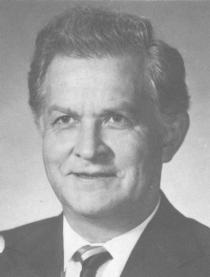 |
| During that time, Ted became known worldwide for his
knowledge of saw conditioning equipment and for the new ideas and
equipment he developed for the lumber industry. After E.P. Armstrong
passed away in 1942, Lloyd Armstrong gave Ted responsibility for not
only production but new engineering as well. During the years that
followed, his influence soon became evident. Both in refinements on
existing Armstrong machines and in new production, clean and innovative
designs became his trademark. As President, he continued and enlarged
upon the straightforward business policies for which Armstrong had
always been known.
Ted was born in Petersburg, Alaska on April 25, 1913, and in his early teens he migrated southward to Portland, Oregon for schooling. He never returned to Alaska to live, but it remained a vivid memory. Ted died on April 10,1984. For a young man from a remote fishing village in Alaska, he achieved more than he ever dreamed when he accepted the challenge to go to work on trial that day in 1936. He will be missed, but like many who have made important contributions to the lumber industry, he will not be forgotten. |
|